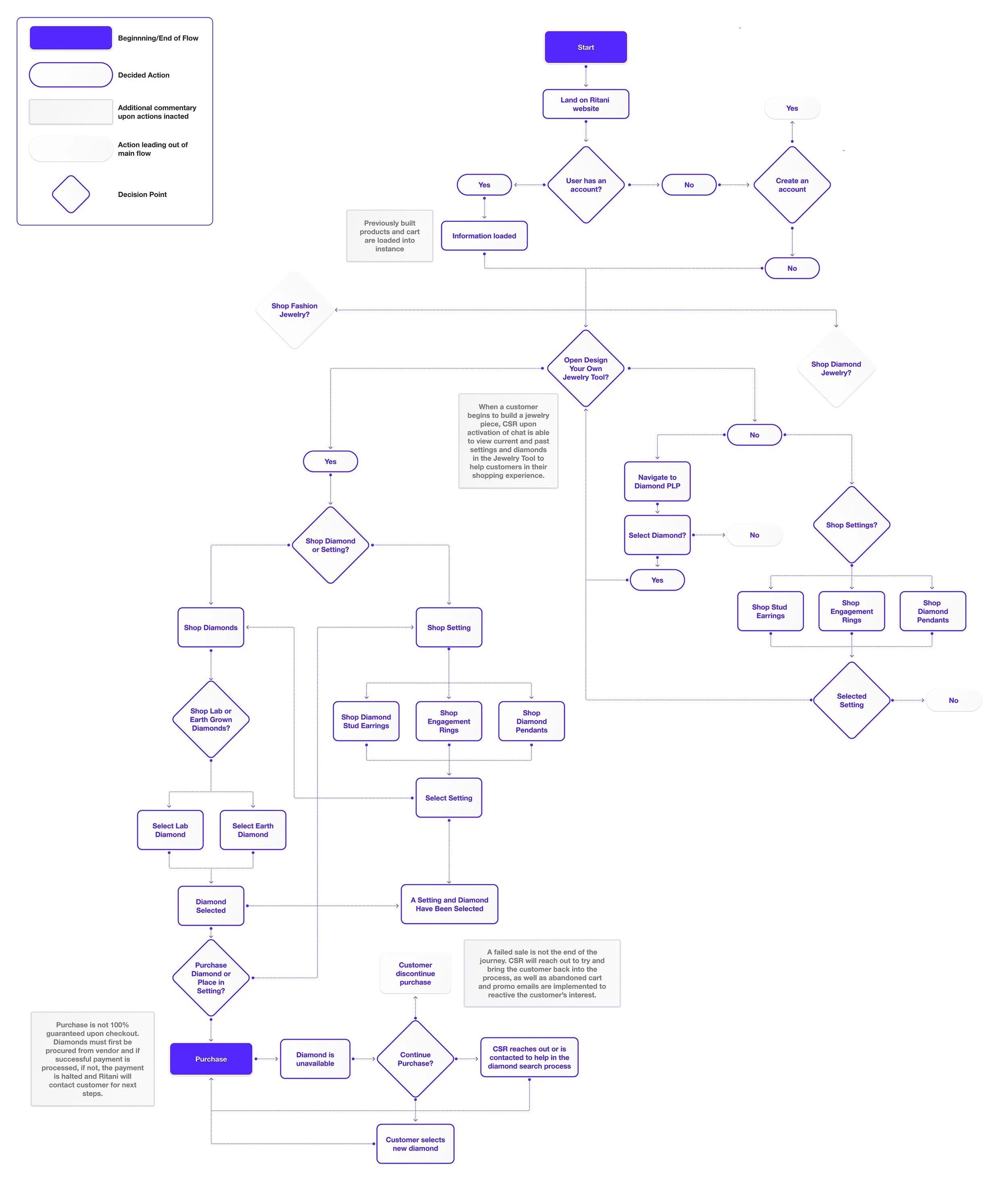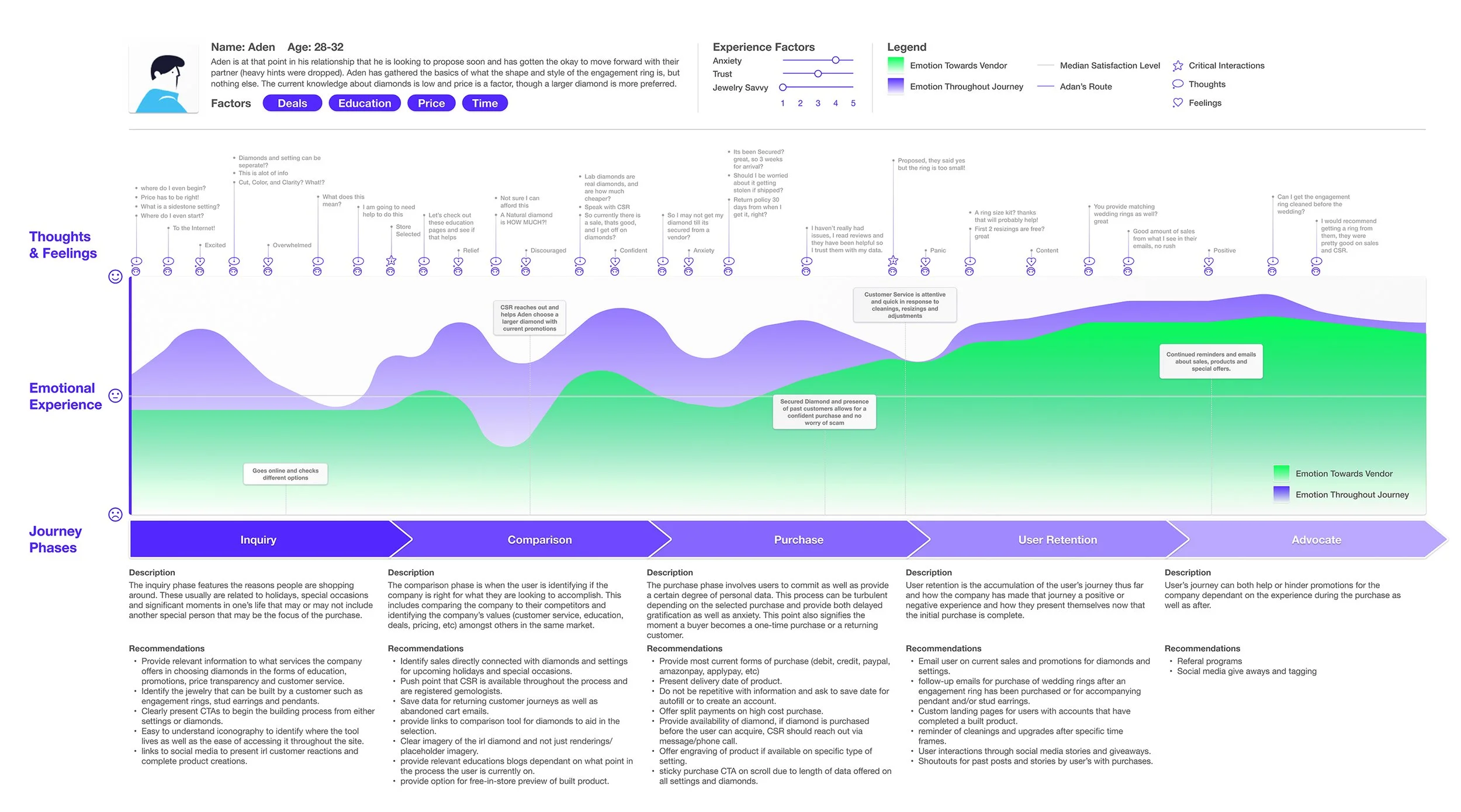The Design your own jewelry tool is a product building system in which the consumer is able to choose a diamond or setting and build out a ring, pendant or stud earring set of their choosing. This allows the consumer to have full control of the quality of their product from beginning to end. The DYOJ tool is a vital staple of the Ritani product catalog as well as the basis for Virtual Shelf. As a company focused on diamonds and in most cases engagement rings, the DYOJ tool provides a large segment of the consumer user base and in that sense a large portion of the company’s income. The tool in its current form was viable but it dealt with the same issues many jewelry companies had to deal with when incorporating this 3-Step progress bar of Select A Diamond, Select A Setting, and Review for purchase. Namely the issue of the indecisive consumer.
Jump To:
The Problem
The Effect Of A Negative DYOJ Experience
Rebuilding the DYOJ Tool
Aftermath
In Hindsight
Wireframe
Workflow
User Journey
The Problem
Choosing the perfect diamond and the most complimentary setting is by no means an easy task; with a number of options; the consumer can change their mind over factors such as Color, Cut, Clarity, Carat, Shape, Metal, and so on, so the chances of going back and forth is almost guaranteed.
The issues that were identified as perpetually occurring were presented by the Customer Service Team as well as Q&A team members:
Upon exchanging settings, the user was not provided with notification that the selected diamond was not a viable option until checkout.
The diamond became unavailable upon the return of the consumer (next day), with no notification message or signifier.
No history of previously selected settings or diamonds.
A user could only view Select A Diamond, Select A Setting, and Review, one dropdown at a time.
Bookmarking a Diamond or Setting had to be done on a Product Listing Page or Product Display Page.
Alternative product selections were only available on Product Display Pages.
A consumer could only change a setting type (engagement ring, pendant, stud earrings) from that specific settings product listing page.
If a consumer changes setting type, previous builds in other categories would not be saved.
Issue with DYOJ reverting to earlier categories of jewelry.
The Effect Of A Negative DYOJ Experience
When placing effort into finding the perfect piece of jewelry, especially an engagement ring, it can be a very high-stress time for an individual. Products such as engagement rings have a time sensitivity due to the planning generally associated with the product. Diamonds in general are not 100% guaranteed purchases due to the nature of the diamond market, in that they must be procured first after a claim is made; and by no means is this instant. Once the diamond is procured shipping, crafting, delivery to factory, and then to consumer, can be a very lengthy process that weighs on the consumer, especially if there were issues occurring from the start with the DYOJ tool. The problems deter customer trust in the company's legitimacy and this puts strain on Customer Service who must build back that trust in hopes of a sale and a continued relationship with that customer. If a customer doesn't reach out to CSR, then the consumer may just leave and not present their experience with the company in a positive light in the future.
Rebuilding the DYOJ Tool
Structurally, when developing the new DYOJ, there were key points that needed to be addressed:
A consumer can access the DYOJ quick and easy and from any page on the website.
Messaging that notifies the consumer of sold diamonds and alternative diamond options.
Messaging that appears when alternative shapes and settings are selected and the option to swap diamond or setting
Ability to keep diamonds and settings separate for different product builds (engagement rings, stud earrings, pendants).
Can view previously selected settings and diamonds and reapply to build.
Link to PLPs through DYOJ
To apply these updates, the tool would need to be redeveloped from the ground up; the logic would not go through a massive change, though the front-end visuals would. Gone would be the vertical bar above filters and replaced with a newly developed sidebar system that had been developed for product quick view. Not only would this free up real estate on the page and move everything up, it would allow for quick access from anywhere on the site for consumers. This new DYOJ or "Customizer" would create a space dedicated to customizing your engagement rings, stud earrings and pendants, all of which can be worked on simultaneously in an uninterrupted flow.
Aftermath
The Customizer in this new form allowed for a smoother experience for consumers. Reflected on feedback from CSR and Q&A quality control, less issues were encountered during the product building process. The benefits were felt most by CSR, who were afforded more time to deal with sales then addressing customer complaints related to the original tool. Since the conception of the Customizer, an application was developed called Virtual Shelf in which small jewelry shops would be able to apply their settings and diamond access to a personalized jewelry building process based off the Customizer and Ritani PDPs and PLPs.
In Hindsight
Looking back on the project, there were a few things I would have liked to have done differently, that I think would have greatly helped measure the effectivness of the project.
Record usage of DYOJ in its original state in which it was only used for Engagement Rings, afterwards compare that amount against its usage as a all in one tool and lastly compare the tool against current day.
Push harder for usage of Hotjar for mapping out the benefits of the added customizer buttons on global nav and PLP filters.
AB test the original tool against the current day version.
have more user Q&A to identify deeper concerns and view points
While I know my start on this project was in the midsts of the Covid Pandemic and the data would have been very skewed, it would have been data that would have allowed for some viable insights into the tool's usage as a whole and any future developments in the customizer timeline.
Wireframe
Workflow








